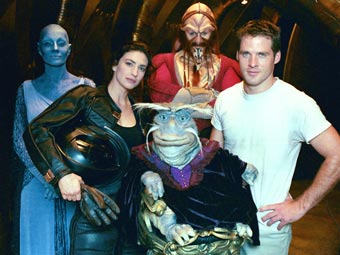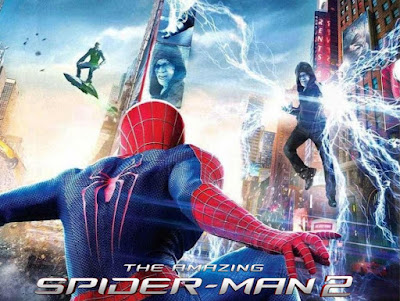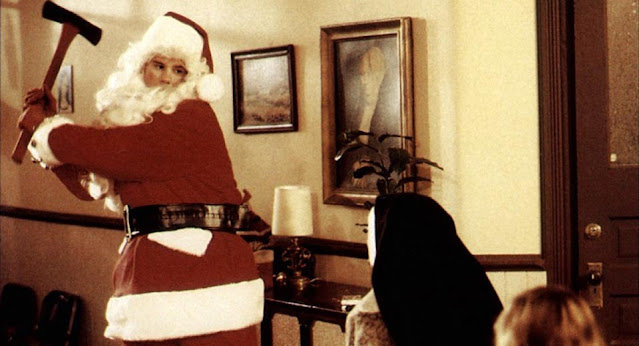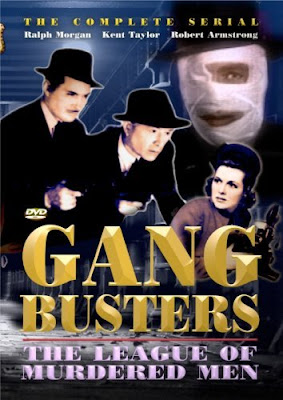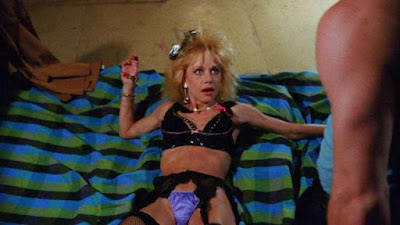Here I’ll plunge into the episodes
straightway, denoting the mythicity of each episode with a (P) for poor, an (F) for fair, or a (G) for good. To any readers who desire background, they may find some here.
“Once Upon a Time in New
York” (G)—Catherine Chandler, grown daughter of a widowed
lawyer-father and comfortable mixing with the rich elites of New
York, suffers life-threatening injury when hired thugs mistake her
for their intended target. Vincent, a man who looks a bit like
Cocteau’s leonine “Beast” from the 1946 film, finds Catherine’s
discarded body and takes her to the World Below to be healed. During
her recuperation Catherine becomes empathically bonded to Vincent,
even after she learns of his freakish appearance. Returning to New
York, Catherine rather rapidly gains the position of Assistant
District Attorney and begins investigating the men who attacked her.
As a mark of her will to become a hero, she even gets trained in
street-fighting by Ron “Superfly” O’Neal. Inevitably Catherine
tracks down the crooks, but her distress brings Vincent racing to her
rescue. Catherine alone witnesses him claw all of the hoods to death.
Afterward a police detective swears that he’ll find the killer, but
though Vincent knocks other undesirables in the course of the first
season, there’s no sign that anyone in the NYPD takes further
notice of the claw-murderer.
“Terrible Savior” (F) —As if to
reflect Catherine’s repressed fears of Vincent’s beastly nature,
a mysterious vigilante begins haunting the subways, clawing evildoers
to death. Since only one suspect is presented, the true killer’s
identity is not hard to guess.
“Siege” (F)—This time Vincent, not
Catherine, initiates the do-gooder action, as he intervenes to repel
ruthless thugs attempting to eject residents from rent-controlled
apartments. During this episode Catherine meets recurring character
Elliot Burch, a handsome millionaire, and is drawn by his charms,
incurring Vincent’s resentment. However, the possibility that Burch
may have criminal ties cools Catherine’s ardor.
“No Way Down” (P)—Vincent is wounded
and hunted by a street-gang and can’t reach any of the vantage
points to return to the Tunnels. Catherine seeks to help him, as does
another young woman, despite being initially horrified by Vincent’s
beast-visage.
“Masques” (F)—On Halloween Vincent
can walk the streets of New York with impunity, and so he shows up at
a party feting an Irish writer whose work he admires. By coincidence
Catherine becomes aware that violent Fenians are planning to
assassinate the writer.
“Beast Within” (P)—One of the
inhabitants of the World Below, a cherished childhood friend to
Vincent, deserts the cooperative in order to work for a mob boss.
When the traitor leads a gang into the Tunnels, Vincent is forced to
take extreme steps.
“Nor Iron Bars a Cage” (G) —Catherine
is offered a more prestigious job that would take her out of New York
City; a rough translation of the fairy-tale motif in which the Beauty
temporarily deserts her Beast. Catherine still loves Vincent but
feels the need to take some precipitate action, so she accepts the
job. Vincent refuses to reveal his torment to her, but his emotions
make him careless. He’s spotted in the world above by Hughes and
Gould, two university scientists who use trank guns to subdue and
capture the beast-man. Both men are hoping to use Vincent to boost
their academic fame, but Hughes becomes distraught when he realizes
Vincent is an intelligent humanoid. Father approaches Catherine when
Vincent is missed, and as she goes looking for him, she realizes that
her feelings for him transcend any mundane advancement goals. She
finds Hughes and almost convinces him to release his captive, but the
obsessed Gould turns violent, resulting both in his death and that of
Hughes. The intense dialogue between Hughes and Vincent—who refuses
to speak in front of Gould because he senses Gould wouldn’t give a
damn—is some of the best in the series, as is the choice of a quote
from Wordsworth to round out the episode.
“Song of Orpheus” (F) —Father, whose
former life aboveground is a mystery to Vincent, makes the
Orpheus-like journey from the underworld, seeking to learn the fate
of an aged “Eurydice,” who turns out to be his former wife from
an annulled marriage. But a schemer seeking to control the old
woman’s wealth kills off her lawyer, and Father is charged with the
crime. Vincent and Catherine expose the real killer. Father’s real
name is revealed to be “Jacob Wells,” which is a clever play upon
an archaic association between wells and the Biblical patriarch.
“Dark Spirit” (F) —Catherine
investigates a voodoo curse that apparently slays an accused
murderer. The priest behind the curse then places a similar curse on
Catherine, and though he uses a psychedelic drug to inflict horrific
visions on the Beauty, there’s some suggestion that the priest too
may be working with “psychic magic.” Catherine is so filled with
fear that she even sees Vincent as a demon, but Vincent gets even
when he finds the malevolent mystic—who dies in a fire in the
belief that Vincent really is a voodoo loa. Tunnel-dweller Narcissa
(oddly named for the Greek legend) displays what may be precognitive
skills.
“A Children’s Story” (P) —Ruthless
criminals seek to exploit orphan children in a modern-day “Fagin”
operation, and Catherine enlists Vincent’s help to stop the abuse.
“An Impossible Silence” (P)—A young
woman from the World Below, deaf but capable of speech, witnesses a
murder. Catherine must find a way to get her to testify in court
without compromising Vincent’s domain.
“Shades of Grey” (F)—Mouse, who
supplies much technical know-how for his fellow Tunnelers, is
ostracized by them for stealing things from the upper world. Then
both Father and Vincent are trapped by a cave-in, and Catherine must
enlist Mouse to rescue both men. The “shades of grey” may refer
to the shady Elliot Burch, whose help Catherine must seek in order to
effect a rescue.
“China Moon” (P) —A young Chinese
woman has been promised in marriage to the son of a powerful Tong
lord, but she loves another man. Her uncle is one of the
surface-world “helpers” for the Tunnelers, and so at first Father
does not want to intervene to help the aggrieved couple. But the
spurned lover gets into a fight with the true love and is
accidentally killed, so the World Below gives the couple refuge. The
Tong leader invades the World Below with a small army, but Vincent
stalks them all, killing some while others die by bad fortune.
“The Alchemist” (F)—This episode
introduces the series’ first recurring villain, Paracelsus, who was
clearly designed as an evil double for Father, given that many of his
innovations made the Tunnels’ colonization possible. However, his
greed for gold caused him to cast out from the society of outcasts,
and now he’s synthesized a new hallucinogenic drug from underground
mushrooms, which he sells above-ground. Catherine, investigating the
drug trade, finds out that the supplier comes from the World Below
and alerts Vincent. When Vincent confronts the villain, Paracelsus
uses the hallucinogen on him, causing Vincent to revert to a
beast-like mentality. Catherine manages to “tame” the beast,
after which Vincent again seeks to levy justice. Paracelsus
apparently dies, but not for long. The story’s “alchemist”
conceit is not well executed—the villain wants gold coins for his
drug, but that’s not much like the alchemist’s stock-in-trade—but
actor Tony Jay made a great villain.
“Temptation” (P) —Catherine’s
colleague Pete is romanced by a lady lawyer from a firm with whom the
D.A.’s office is in conflict. Sure enough, she’s been assigned to
undermine Pete by luring him away from prosecuting crimes, and when
her attempt fails, her criminal bosses try to frame Pete. While all
of this goes on, Vincent ventures into the Crystal Caves to find a
gift for the anniversary of his meeting with Catherine. Narcissa is
mentioned but not seen.
“Promises of Someday” (F)—Devin, a
new employee in Catherine’s office, arouses her suspicions. She
soon learns that he’s a former dweller from the World Below, who
kept the dwellers’ secret but ceased living among them, preferring
to jaunt around the world. Though Devin and Vincent were best friends
in youth, Father always treated Devin as if he could do nothing
right, thus inculcating Devin’s resentment of “favored son”
Vincent. Father belatedly reveals that Devin is his natural son,
though Father’s reasons for concealing the relationship seem
strained at best. In the end Devin goes back to world-traveling but
has put some of his past ghosts to rest.
“Down to a Sunless Sea” (P) —Despite
the title’s invocation of Coleridge and the reading of some lines
from “Kubla Khan,” the episode is a dull “deranged killer”
tale. Catherine re-connects with Steven, a former boyfriend, but
though he no longer means anything to her, Steven has other ideas.
Vincent has some uneasy premonitions about Steven that don’t stem
from jealousy, but not until Steven reveals his plans for Catherine
does Beast race to the side of Beauty.
“Fever” (P)—Mouse unearths a buried
ship full of priceless treasures from a cavern, and many of the
dwellers begin to remember the feverish allure of easy money. Even as
the Tunnel-people fall out over the treasure, one of their number,
Cullen, absconds with a jeweled prize and tries to sell it to an
unscrupulous dealer. The dealer forces Cullen to take him into the
World Below, but with Vincent’s help Cullen turns the tables, and
the thief plunges into a mysterious abyss compared to Hell.
“Everything is Everything” (P)—After
a charming gypsy boy steals Catherine’s wallet, she becomes
involved in helping him prove his father’s innocence of a crime
that caused the boy to become an outcast.
“Ozymandias” (G)—The title refers to
Elliot Burch, who has invested heavily in a new building-project.
Some activists think it’s just gentrification that will hurt the
poor, but Catherine knows that if the project is completed it will
expose the World Below. Elliot proposes to Catherine. Though she does
not love him, Catherine considers accepting his proposal in exchange
for his cancelling the project. Vincent’s heart is torn asunder not
just at the prospect of losing Catherine but also at her entering a
loveless marriage. Fortunately for the heroine, Elliot is so invested
in the ego-boost of his project that he won’t accept her terms.
Later, Catherine realizes that she dodged a bullet because Elliot was
involved in illegal attempts to harass his political opponents. In a
rare denouement dependent on Lady Justice rather than lion’s claws,
an injunction dooms the building-project, saving the Tunnels and
leaving Elliot with nothing—whereupon the Shelley poem “Ozymandias”
is read aloud by a narrator to underscore his desolation.
“A Happy Life” (G)—In a rare episode
involving no crime elements, Catherine suddenly becomes woeful for
the memory of her mother, who died when Catherine was ten (and who
has not been substantially referenced in prior episodes). Catherine
becomes so obsessed that she talks to a psychologist, admitting that
part of her psychic dilemma is that she cannot be with the man she
truly loves. Implicit to the drama is the knowledge that she and
Vincent have known one another over a year by this time, and now the
impossible love has become more torturous, particularly because she
envies the normal life her mother and father had. This is expressed
by Catherine’s overt envy of the normal life a college friend has
with her husband and child. For the first time Catherine considers
deserting the normal world for the Tunnels, proposing that she join
Vincent in the World Below, if only on a trial basis. Vincent nobly
refuses her notion, claiming he knows she can’t really leave the
normal world. Catherine takes a leave from her job and joins her
college friend for an extended visit—but in a tear-jerking finale,
she realizes that she wants Vincent more than normalcy. The
conclusion still leaves the love in its impossible configuration,
though.
